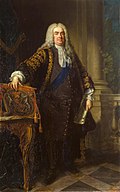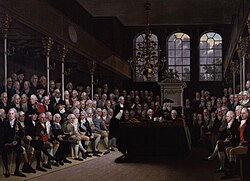Prime Minister of the United Kingdom
The prime minister of the United Kingdom or British prime minister is the head of government in the United Kingdom. The prime minister controls the Government of the United Kingdom through the cabinet. The prime minister is the chairman of the British cabinet and a member of the Privy Council. It is normal for the prime minister to be the leader of the political party which has a majority in the House of Commons.
| Prime Minister of the United Kingdom | |
|---|---|
 Royal arms of His Majesty's Government | |
 | |
| Style | Prime Minister (informal) The Right Honourable (formal) (UK and Commonwealth) His Excellency (diplomatic) |
| Status | Head of Government |
| Reports to | Charles III |
| Residence | 10 Downing Street |
| Seat | Westminster |
| First holder | Sir Robert Walpole |
| Unofficial names | P.M. |
| Deputy | Angela Rayner |
The prime minister is not the head of state, but is the most important politician in Parliament. By tradition, the monarch of the United Kingdom chooses the prime minister. The monarch chooses the leader of the political party with enough votes to get laws passed in Parliament.[1]
Keir Starmer (Labour) became prime minister on 5 July 2024.[2]
Background
The Prime Minister (PM) is usually the leader of the political party which wins most seats in the House of Commons after a general election. There are 650 available seats in the Commons. In each general election the UK electorate vote for their own local member of parliament (MP) to represent their constituency, not for the prime minister. MPs represent their local constituency in the chamber to vote for bills which eventually become laws or statutes, if successful. The prime minister is a member of parliament.
The first prime minister was Robert Walpole in 1721. He was known as the "First Lord of the Treasury". The first person to be use the title "prime minister" officially was Henry Campbell-Bannerman in 1905.
Well-known prime ministers in the 20th century included David Lloyd George, Stanley Baldwin, Winston Churchill, Clement Attlee, Margaret Thatcher, and Tony Blair. The prime ministers usually live and work at 10 Downing Street or Chequers while in office. Chequers was donated to the country by Winston Churchill.
There are several other official residences, some owned by the government, others held by trusts. The 3,500 acres (1,400 ha) Chevening House estate, in Kent is an example. Dorneywood is another.[3]
Living former prime ministers
There are eight living former British prime ministers:
Sir John Major
(1990–1997)
29 March 1943 (aged 82)Sir Tony Blair
(1997–2007)
6 May 1953 (aged 72)Gordon Brown
(2007–2010)
20 February 1951 (aged 74)David Cameron
(2010–2016)
9 October 1966 (aged 59)Theresa May, Lady May
(2016–2019)
1 October 1956 (aged 69)Boris Johnson
(2019–2022)
19 June 1964 (aged 61)Liz Truss
(2022)
26 July 1975 (aged 50)Rishi Sunak
(2022–2024)
12 May 1980 (aged 45)
Prime Minister Of The United Kingdom Media
Sir Robert Walpole was the first to hold the position of Prime Minister.
Prime Minister Neville Chamberlain alongside his cabinet on the eve of World War II in September 1939
Prime Minister David Cameron announcing the approval of more free schools across the country as a part of his education policy on 9 March 2015
Prime Minister Lord Palmerston during a debate in Parliament over the Cobden–Chevalier Treaty in February 1860
Prime minister Theresa May (in the middle) alongside G7 leaders signing statement against Terrorism at the 2017 Taormina summit
Prime minister William Pitt the Younger addressing the House of Commons on the outbreak of war with France in 1793
Queen Elizabeth II receiving prime minister Tony Blair after winning a third term in office on 6 May 2005
The current prime minister, Keir Starmer, speaking in the House of Commons on 4 September 2024
Prime minister Rishi Sunak announces his resignation outside 10 Downing Street, 5 July 2024.
Related pages
References
- ↑ Technically, it is expressed as: "the Parliament of the United Kingdom's approval for the British monarch's speech from the throne".
- ↑ "Starmer Is U.K.'s New Prime Minister". New York Times. 5 July 2024.
- ↑ It is an 18th-century house near Burnham in South Buckinghamshire. Pevsner, Nikolaus; Elizabeth Williamson; Geoffrey K Brandwood (1994) [1960]. Buckinghamshire (2nd ed.). London: Penguin Books. p. 211. ISBN 0-14-071062-0.


















